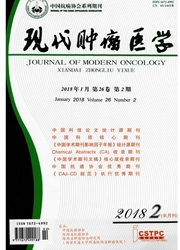

 中文摘要:
中文摘要:
目的:肺癌是威胁人类健康最常见的恶性肿瘤之一,并且已有超过1/3的NSCLC患者诊断时发生了转移。早期判断肺癌的转移对于肺癌患者的治疗和预后有非常重要的意义。Tenasein-C(TNC)具有调节细胞发生、增殖、迁移、分化的作用。本文主要研究Tenascin-C(TNC)蛋白在非小细胞肺癌(NSCLC)中的表达,探讨Tenascin-C与NSCLC临床病理特征之间的关系。方法:采用免疫组织化学En Vinsion法检测70例NSCLC及其正常组织内TNC蛋白的表达情况,并分析肺癌组织中TNC的表达和临床病理特征之间的关系。结果:TNC在NSCLC组织内高表达而在正常组织中不表达。TNC在腺癌和鳞癌中表达差异无统计学意义(P〉0.05)。TNC表达与NSCLC的TNM分期、有无侵及胸膜及淋巴结转移有关(P〈0.05),但其表达与肿瘤直径、病理分级无关(P〉0.05)。结论:结果显示TNC的表达与肺癌的分类无关。进一步的分析表明,TNC表达与NSCLC的肿瘤的TNM分期、有无胸膜浸润及淋巴结转移有关,但其表达与肿瘤直径、病理分级无关。故TNC在NSCLC组织中的表达与NSCLC的侵袭和转移有关,其表达可能有助于肿瘤细胞的转移和癌细胞浸润,检测其表达有助于判断肺癌患者的预后。
 英文摘要:
英文摘要:
Objective: Lung cancer is one of the most common malignant tumors threatening human health in the world, one third of the NSCLC patients have shifted at diagnosis. Early judgment of lung cancer metastasis has a very important significance on treating and predicting the prognosis of NSCLC patients. Tenasein-C (TNC) has to regulate the action of cells, proliferation, migration and differentiation. To investigate the expressions of TNC proteins in non small cell lung cancer (NSCLC) and explore the relationship between TNC and clinical pathological features in NSCLC. Methods: The expressions of TNC protein were detected with EnVinsion immunohistoehemistry method in the tumor tissues and normal tissue from 72 cases of NSCLC patients. The relationship between the TNC expression and NSCLC clinical pathological features was evaluated. Results: TNC was expressed highly in NSCLC tissues, but not in normal tissues expression. TNC expression had no significant difference between in lung squamous cell carcinoma and adenocarcinoma (P〉0.05). The expression of TNC protein was associated with the TNM stage, lymph node metastasis, tumor invasion pleura (P〈0.05), but not with the patients tumor diameter and pathological grades (P〉0.05). Conclusion: Further analysis showed that TNC expression had associated with the tumor TNM staging of NSCLC, presence ofpleural invasion and lymph node metastasis, but its expression had nothing to do with the tumor diameter, pathologic stage. The TNC was high expression in the NSCLC, which may play an important role in invasion and metastasis. In the NSCLC, its expression may contribute to the transfer of tumor cells and cancer cells infiltration, detecting its expression helps us to judge the survival time of lung cancer patients.
 同期刊论文项目
同期刊论文项目
 同项目期刊论文
同项目期刊论文
 期刊信息
期刊信息
